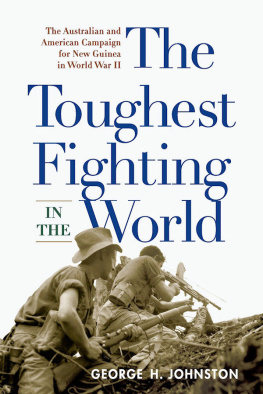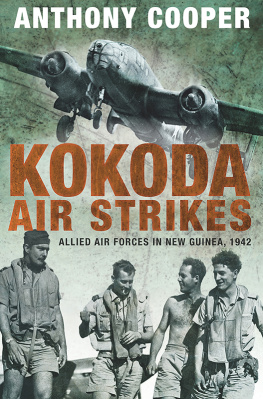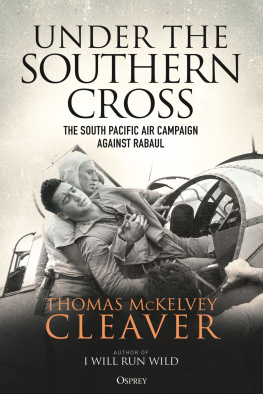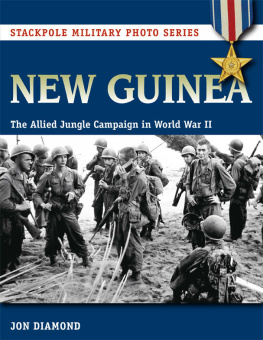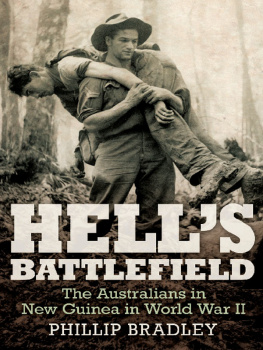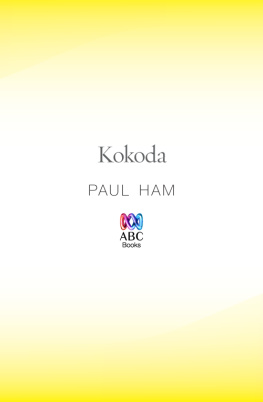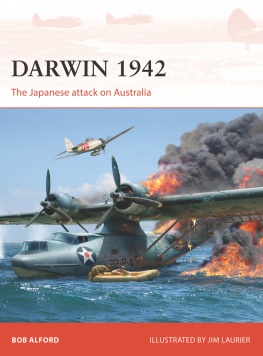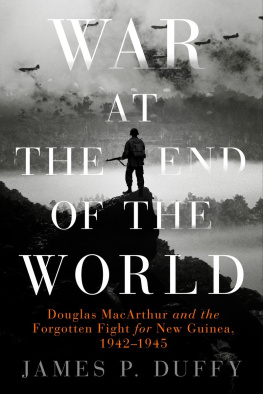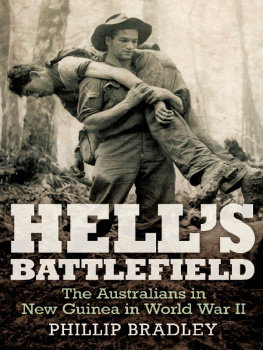I. TROPIC SIDESHOW
January 23, 1942March 14, 1942
Overture
THE Battle for New Guinea has begun. It is January 23, 1942. It seems strange. They're still fighting in Malaya. Why are the Japs striking also at this little tropical outpost less than five degrees below the equator? That's only one of the questions. There are a lot of loose threads to be tied together on this story.
The communiqu doesn't say very much. Radio communication with Rabaul ceased at 4 P.M. A strong Japanese invasion force landed somewhere about dawn and drove our little garrison of 1400 men from their fixed defense positions. It was believed that the Australians were continuing resistance in the hills.
So Rabaul had fallen and the invader has at last gained a foothold in Australian mandated territory. Looking back over the last fortnight or so it is easy to see how the show has been building up.
A small force of Japanese bombers came over Rabaul on 4 January. No doubt the enemy was vitally interested in this cornerstone in the defense strategy of Australia's outlying island barrier. Controlling St. George's Channel, main gateway to the scattered islands of the Bismarck Archipelago, Rabaul's magnificent harbor, cupped within the 1400-foot girdle of mountains and smouldering volcanoes, could hold a large naval force; its twin airfields could base many bombers and fighters. Now bombs have fallen among the coconut palms and Casuarinas of this little tropic port which was once the capital of German New Guinea (where Australians first went into action against Germany in 1914), and capital of British New Guinea until the torrent of lava and ash and pumice from erupting Matupi drove the administration to a new capital at Lae only a few years ago.
By the beginning of this week it was pretty evident that the preliminary shadow-sparring had ended. On Monday between 100 and 130 Japanese fighters, bombers and dive-bombers were over Rabaul showering high-explosive bombs and incendiary bullets on the ash-covered buildings. The freighter Hersteen was blown up at the wharf with eleven men killed, others wounded. The air was filled with planes, only five of which were Australianfive slow Wirraways that went up to give battle to more than 100 enemy aircraft each of which was faster, larger and better armed. All five were shot down. But three Japanese planes came down. One crashed on the lava-hardened slopes of Matupi and in the cockpit were found the bodies of two Japanese. In each man's hand was clutched a little cotton bag filled with sand from some picturesque little town back in the Japanese islands. They were a long, long way from home. There were bodies of Australians and bodies of Japanese to be buried in the quiet little cemetery behind the town where Australia's first dead of the last war rested side by side with some of their enemies.
Next day Japanese cruisers were steaming off the coast of New Ireland, hurling shells into the pretty little tropical town of Kavieng. Funny thing that the Japanese Navy operated in these same waters in the last waras our allies! The naval guns swung inboard and, in wave after wave, 40 bombers and 20 fighters swept in to plaster almost undefended Kavieng. Not until the town was a shambles of rubble and shattered lath and plaster did the Imperial Japanese Marines make the landing that conquered the town. Two hundred and fifty miles to the westward, Lorengau, capital of the Admiralty Islands, was being raided, and at noon the Japanese bombers struck at the New Guinea mainland, dropping high explosive on Madang, formerly Kaiser Wilhelmshaven, capital of the wild Sepik district. Rabaul, this Tuesday, had a quiet day in which to bury its dead, its first dead of the Second World War, of the first war in the Pacific. Wednesday came and Japan continued to introduce its New Order to the tropic towns with a heavy hand. Over Lae, undefended capital of British New Guinea, 60 bombers and fighters had a field day and in less than an hour property worth almost $1,000,000 was ravaged by bombs or destroyed by flames. Keith Parer, famous goldfields pilot, met swift death in the cockpit of his plane as he tried to get it off the drome to safety. Some of the Chinese and natives, assisted by the low whites, looted and plundered the town, half mad with the whisky they had stolen from the shattered hotels. Through blinding tropical rain the civilian population streamed inland to the terrible swamps and jungles that meant discomfort, hunger and diseasebut also meant safety. Up in the mountains Bulolo, also, was bombed.
The events of yesterday foretold what would happen today. The Japanese Air Force went where it wanted to go. In Malaya we had a few Brewster Buffalo fighters. Not much good, but something. Out here, we had nothing. Bombs fell on Kieta, in the North Solomons; on Tulagi, in the South Solomons; on Bulolo, in New Guinea; on Rabaul, in New Britain. Some of this was diversion, some preparation. Early in the day we pondered the question as to where the blow would fall. The answer must have been clear to the handful of men charged with the defense of Rabaul. From 9 A.M. the sky was filled with aircraftall Japanese. For almost an hour the coastal fort at Praed Point was bombed and dive-bombed until the guns were blown out of the ground and half a dozen young Australian gunners were buried beneath the shattered concrete and twisted steel.
Later came a report that a Japanese invasion fleet was sheltering in the lee of Watom Island, off the coast to the north of the town, a fleet of five big transports, three heavy cruisers, three destroyerswith an aircraft carrier out to sea and other ships heading south from Truk. In Rabaul there was the roar and thunder of explosions as engineers carried out essential demolition work. Why is our defense so much a policy of scorching the earth, of only token resistance, of strategic withdrawals? A battalion of the A.I.F. and a few small units of the Australian Militia and Permanent Forces moved in to prepared positions. But what could they do against this overwhelming force sheltering behind Watom?
Today has provided the answer to that: Nothing beyond fighting a beachhead defense for a few short hours and then retiring according to plan. Tonight there is only a grim silence from Rabaul. Japan has, for the first time, advanced and conquered south of the equator. She has, in a few vital hours, captured one of the greatest natural defense points and naval bases of the South Pacific. Only one Australian base stands between Rabaul and the Australian mainlandthe little garrison of Port Moresby, on the south coast of Papua. And how long can Moresby hold?
Friday The Thirteenth
New Guinea was somewhere in the blue-gray haze ahead. The camouflaged airliner was droning evenly northward. Below was the dazzling emerald green of the Great Barrier Reef. It was warm in the cabin and I was half dozing, half thinking.
It was Friday, February the thirteenth. Although Australia had yet to receive the definite news for which it was being prepared by half-hints and solemn warnings, Singapore had already fallen to the Japanese. The black stain of Japan's co-prosperity sphere in East Asia was running southward rapidly. Since the day, little more than two months before, when Japan had dropped her twin masks of hypocrisy and suave politeness and had struck devastating blows at Pearl Harbor, Singapore and Manila, the new enemy had moved swiftly. Armchair prophets who had written smugly about Japan's fourth-rate air force, third-rate army, and navy that has yet to be proved even second rate were scratching away with their pens to prove that Nippon had gained victory by treachery, not by skill at arms. They refused, even then, to concede that it might have been something of both.
Now they had crushed the impregnable fortress of Singaporethe fortress whose guns had faced the wrong way. They were investing the Philippines. They had struck at Sarawak, at Borneo, at the Celebes. They were simply taking no notice of the experts who told them that they were stretching their supply lines far beyond the limits of safety. They had thrown great tentacles across the western and southwestern Pacific, and the extreme end of their longest tentacle was about 3000 miles from Tokyo. They had gained a foothold in New Guinea and were less than 1000 miles from the continent of Australia. But between their new base at Rabaul and the green seaboard of North Queensland stood the Australian garrison of Port Moresby, already bombed by Kawanisi flying boats based on Rabaul. And I was going to Port Moresby.

